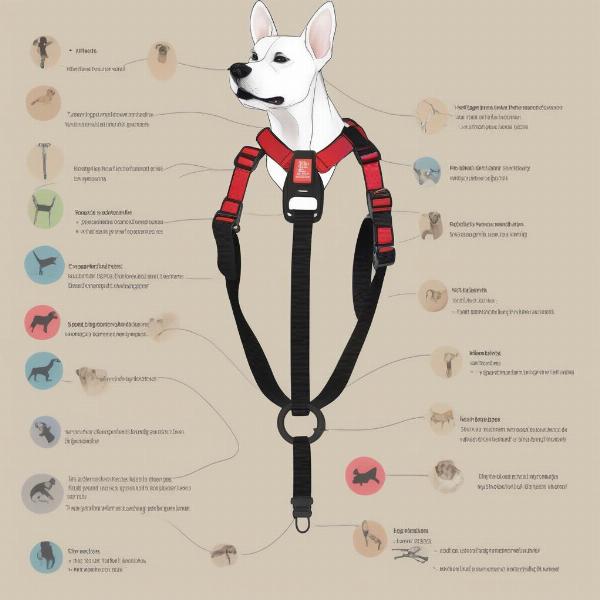Choosing the right dog lead and harness set can significantly impact your dog’s comfort, safety, and your overall walking experience. Whether you’re a new dog owner or a seasoned pro, finding the perfect combination can be a daunting task with the plethora of options available. This guide will walk you through everything you need to know about dog lead and harness sets, from understanding the different types to choosing the best fit for your furry friend.
Types of Dog Leads and Harnesses
There’s a wide variety of lead and harness sets on the market, each designed for different needs and preferences. Understanding the key differences can help you make an informed decision.
Traditional Collar and Lead Sets
This classic combination is a staple for many dog owners. Collars come in various materials like leather, nylon, and metal, while leads typically match the collar material. While simple and often affordable, collar and lead sets can put pressure on a dog’s neck, especially if they pull.
Harnesses and Leads: Comfort and Control
Harnesses distribute pressure more evenly across a dog’s chest and back, reducing strain on the neck and trachea. They offer better control, particularly for strong pullers, and are often recommended for brachycephalic breeds (dogs with short noses) like Bulldogs and Pugs. Harnesses come in various styles, including front-clip, back-clip, and dual-clip.
 Different Types of Dog Leads and Harnesses
Different Types of Dog Leads and Harnesses
Specialized Lead and Harness Sets for Specific Activities
Certain activities call for specialized equipment. For example, a retractable lead offers more freedom for exploration in safe open spaces, while a hands-free running leash is ideal for jogging with your dog. Similarly, a no-pull harness is specifically designed to discourage pulling behavior.
Choosing the Right Fit for Your Dog
Finding the perfect fit is crucial for both comfort and effectiveness.
Measuring Your Dog
Use a soft measuring tape to measure your dog’s girth (around the chest, behind the front legs) and neck circumference. Refer to the manufacturer’s size chart for the specific lead and harness set you’re considering.
Considering Your Dog’s Breed and Size
Certain harnesses are better suited for specific breeds. For instance, a no-pull harness might be beneficial for a large, strong breed prone to pulling, while a lightweight harness is ideal for a smaller dog.
Adjusting the Lead and Harness
Once you’ve chosen a set, ensure it’s properly adjusted. The harness should be snug but not restrictive, allowing two fingers to fit between the harness and your dog’s body.
Caring for Your Dog Lead and Harness Set
Proper care will prolong the life of your equipment.
Cleaning and Maintenance
Most leads and harnesses can be hand-washed with mild soap and water. Always air dry to prevent damage. Regularly inspect for wear and tear and replace if necessary.
Storage
Store your lead and harness set in a cool, dry place away from direct sunlight. This will prevent fading and deterioration.
What to Look for in a Quality Dog Lead and Harness Set
Durability, comfort, and safety are key factors to consider.
Material
Opt for durable materials like nylon or leather. Ensure the hardware is sturdy and rust-resistant.
Construction
Check for reinforced stitching and strong buckles. A well-constructed set will withstand regular use.
Safety Features
Reflective strips are beneficial for nighttime walks, increasing visibility. A comfortable handle is also essential for a pleasant walking experience.
Conclusion
Choosing the right dog lead and harness set is a crucial part of responsible dog ownership. By considering your dog’s individual needs, breed, and activity level, and by understanding the different types of sets available, you can ensure comfortable and safe walks for both you and your furry companion. Remember to always prioritize a good fit and proper maintenance to maximize the lifespan of your equipment.
FAQ
- What type of harness is best for a dog that pulls? A front-clip or no-pull harness can be effective in discouraging pulling behavior.
- How often should I replace my dog’s lead and harness? Replace them as soon as you notice any signs of wear and tear, such as fraying or broken buckles.
- Can I use a harness on a puppy? Yes, harnesses are often recommended for puppies as they are gentler on their developing necks.
- What is the best material for a dog lead? Nylon and leather are popular choices for their durability and comfort.
- How do I measure my dog for a harness? Measure the girth around the chest, behind the front legs, and the neck circumference.
- What is a dual-clip harness? A dual-clip harness has leash attachment points on both the front and back, offering versatility in training and control.
- Are retractable leads safe for all dogs? Retractable leads can pose safety risks if not used responsibly. They are generally not recommended for dogs that pull strongly or for crowded areas.
ILM Dog is your global resource for expert advice on dog care and nurturing. From breed selection and health to training and nutrition, we provide practical, trustworthy information to dog lovers of all experience levels. Our expertise covers various areas of dog care, including selecting the perfect dog lead and harness set for your canine companion. Contact us for further assistance at [email protected] or +44 20-3965-8624. Visit ILM Dog for more valuable resources and expert guidance.